NAMIBIA
NAMIBIA
NAMIBIA
The land that time forgot
The land that time forgot
The land that time forgot
Experience the stunning, stark beauty of the world's oldest desert with its vast landscapes that seem to stretch to eternity and discover a rich diversity of wildlife that's uniquely adapted to one of the most hostile environments on earth... This is Namibia - an ancient land of contrasts and intriguing cultures.
From the rich, red dunes of Sossusvlei and the Namib to the dramatic, otherworldly peaks of the Brandberg and from the cool, fog-covered sands of the Skeleton Coast to the deserted ghost town of Kolmanskop, Namibia offers a wealth of destination choices. Vast, intriguing
Experience the stunning, stark beauty of the world's oldest desert with its vast landscapes that seem to stretch to eternity and discover a rich diversity of wildlife that's uniquely adapted to one of the most hostile environments on earth... This is Namibia - an ancient land of contrasts and intriguing cultures.
From the rich, red dunes of Sossusvlei and the Namib to the dramatic, otherworldly peaks of the Brandberg and from the cool, fog-covered sands of the Skeleton Coast to the deserted ghost town of Kolmanskop, Namibia offers a wealth of destination choices. Vast, intriguing
Experience the stunning, stark beauty of the world's oldest desert with its vast landscapes that seem to stretch to eternity and discover a rich diversity of wildlife that's uniquely adapted to one of the most hostile environments on earth... This is Namibia - an ancient land of contrasts and intriguing cultures.
From the rich, red dunes of Sossusvlei and the Namib to the dramatic, otherworldly peaks of the Brandberg and from the cool, fog-covered sands of the Skeleton Coast to the deserted ghost town of Kolmanskop, Namibia offers a wealth of destination choices. Vast, intriguing



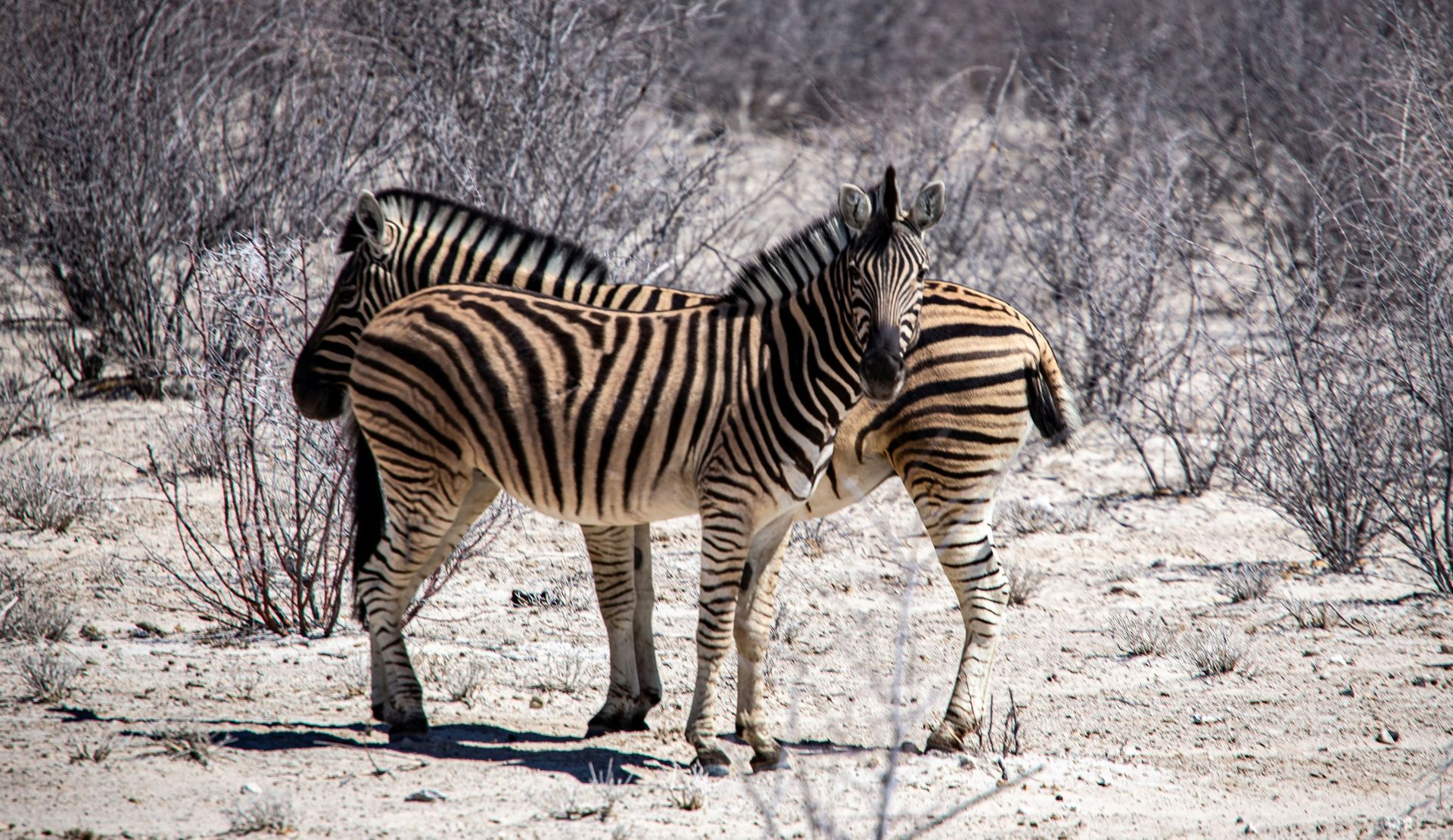
Slide title
Write your caption hereButton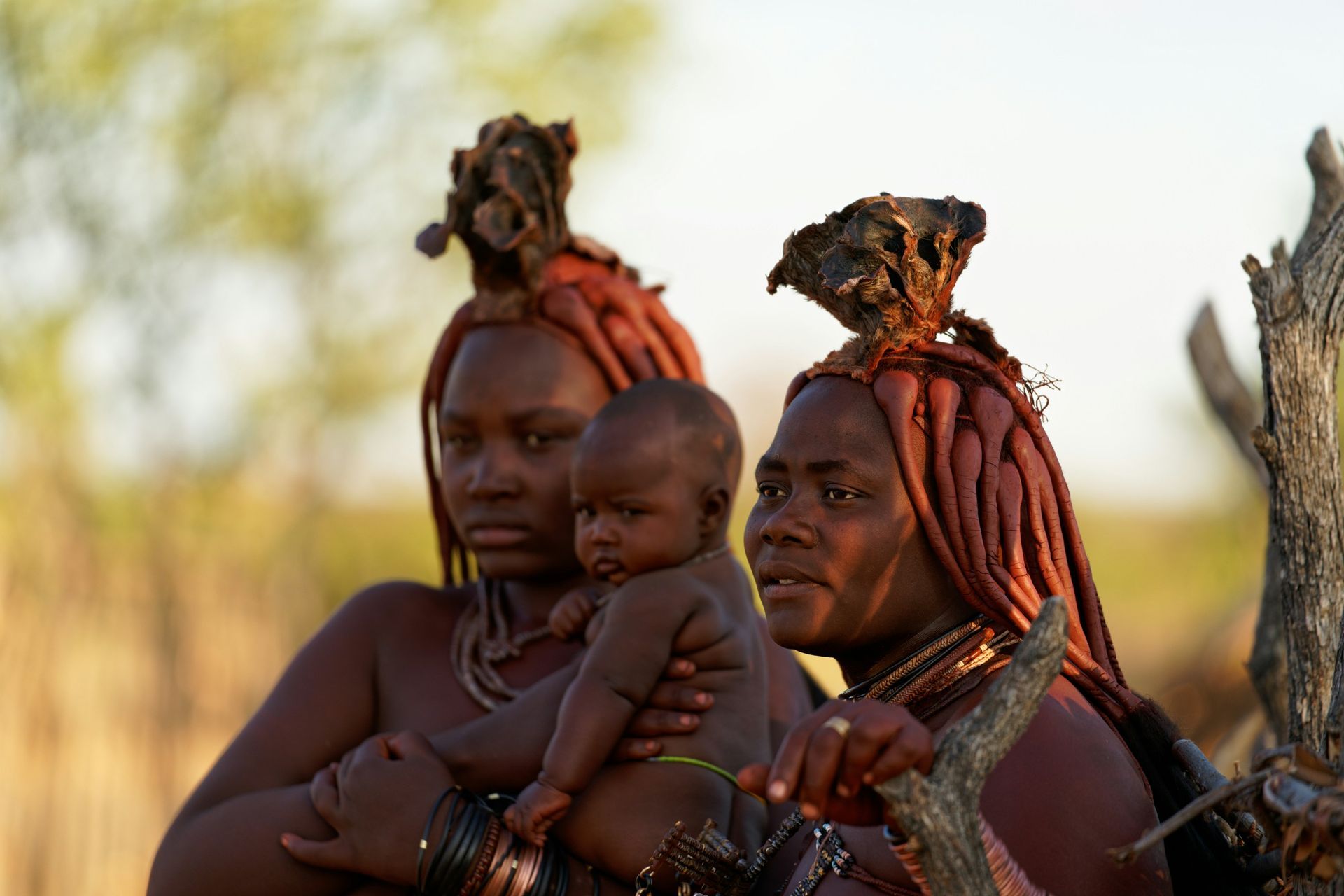
Slide title
Write your caption hereButton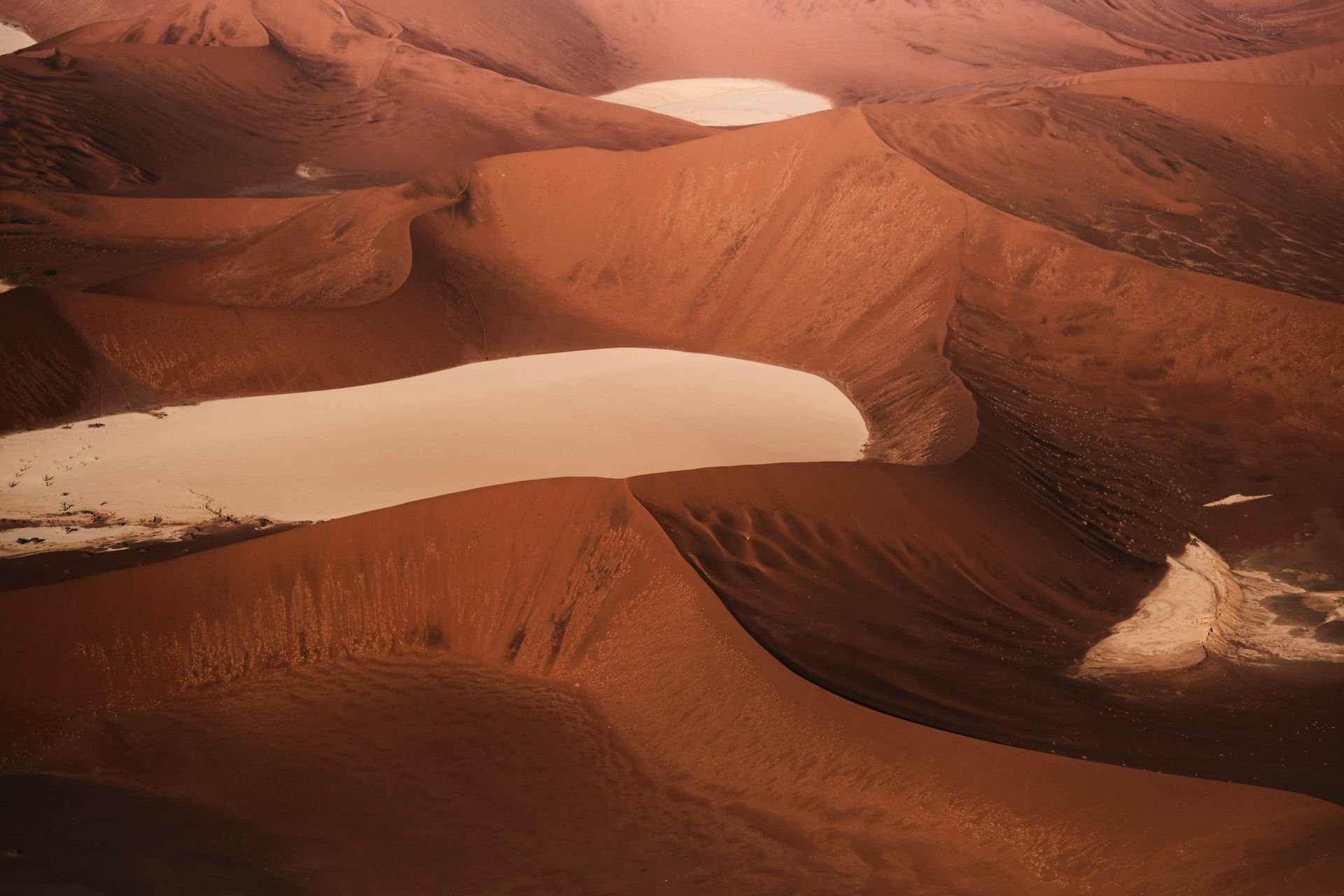
Slide title
Write your caption hereButton
About Namibia
The country is blessed with a rich diversity of wildlife in a kaleidoscope of different environments including the arid pans of Etosha, the endless horizons of the Namib Naukluft, the lush and verdant Caprivi Strip and the wide open spaces of Damaraland. Its deserted coastline is littered with the slowly rusting carcasses of an untold number of wrecked ships and huge colonies of Cape fur seals.
Uniquely adapted wildlife species like desert elephants, gemsbok and ostrich are complemented by an array of tiny wonders that spend their lives in the slip faces of a myriad sand dunes... Creatures like the palmato (or web-footed) gecko, the white lady spider, shovel-snouted lizard and tok-tokkie beetle are as intriguing as they are bizarre.
Namibia's culture is as diverse as its wildlife, from the San tribes of Africa's First Nations to the colourful Herero people and fascinating Himba, whose women smear themselves with otjize - a paste of butter, fat and red ochre that's sometimes scented with aromatic resin - giving them a rich, red appearance.
A safari to this amazing south-west African country is not to be missed!
Here are some of the top destinations in Namibia...

Slide title
Write your caption hereButton
Slide title
Write your caption hereButton
Slide title
Write your caption hereButton
About Namibia
The country is blessed with a rich diversity of wildlife in a kaleidoscope of different environments including the arid pans of Etosha, the endless horizons of the Namib Naukluft, the lush and verdant Caprivi Strip and the wide open spaces of Damaraland. Its deserted coastline is littered with the slowly rusting carcasses of an untold number of wrecked ships and huge colonies of Cape fur seals.
Uniquely adapted wildlife species like desert elephants, gemsbok and ostrich are complemented by an array of tiny wonders that spend their lives in the slip faces of a myriad sand dunes... Creatures like the palmato (or web-footed) gecko, the white lady spider, shovel-snouted lizard and tok-tokkie beetle are as intriguing as they are bizarre.
Namibia's culture is as diverse as its wildlife, from the San tribes of Africa's First Nations to the colourful Herero people and fascinating Himba, whose women smear themselves with otjize - a paste of butter, fat and red ochre that's sometimes scented with aromatic resin - giving them a rich, red appearance.
A safari to this amazing south-west African country is not to be missed!
Here are some of the top destinations in Namibia...

Slide title
Write your caption hereButton
Slide title
Write your caption hereButton
Slide title
Write your caption hereButton
About Namibia
The country is blessed with a rich diversity of wildlife in a kaleidoscope of different environments including the arid pans of Etosha, the endless horizons of the Namib Naukluft, the lush and verdant Caprivi Strip and the wide open spaces of Damaraland. Its deserted coastline is littered with the slowly rusting carcasses of an untold number of wrecked ships and huge colonies of Cape fur seals.
Uniquely adapted wildlife species like desert elephants, gemsbok and ostrich are complemented by an array of tiny wonders that spend their lives in the slip faces of a myriad sand dunes... Creatures like the palmato (or web-footed) gecko, the white lady spider, shovel-snouted lizard and tok-tokkie beetle are as intriguing as they are bizarre.
Namibia's culture is as diverse as its wildlife, from the San tribes of Africa's First Nations to the colourful Herero people and fascinating Himba, whose women smear themselves with otjize - a paste of butter, fat and red ochre that's sometimes scented with aromatic resin - giving them a rich, red appearance.
A safari to this amazing south-west African country is not to be missed!
Here are some of the top destinations in Namibia...
DAMARALAND
A breathtakingly beautiful mountainous region of Namibia, Damaraland is notable for its dramatic landscapes, the towering peaks of the Brandberg - the country's highest mountain range - and ancient petroglyphs carved into the rocks of Twyfelfontein thousands of years ago.
A petrified forest that dates back millions of years to a time when dinosaurs roamed what was then a tropical paradise stands testament to the astounding history of this land.
Damaraland's rugged yet beautiful rocky landscape is characterised by valleys and dry riverbeds that carve their way through deep gorges and ancient geological features. This is home to Namibia's desert-adapted elephants with elongated limbs and broad soles that are able to withstand the extreme environment, rock and sand. They travel huge distances through the dry river beds in search of water.
You will also find the critically endangered desert lion in this region as well as various endemic desert plants such as the photogenic but poisonous Euphorbia virosa and the ancient Welwitschia mirabilis.

Slide title
Write your caption hereButton
Slide title
Write your caption hereButton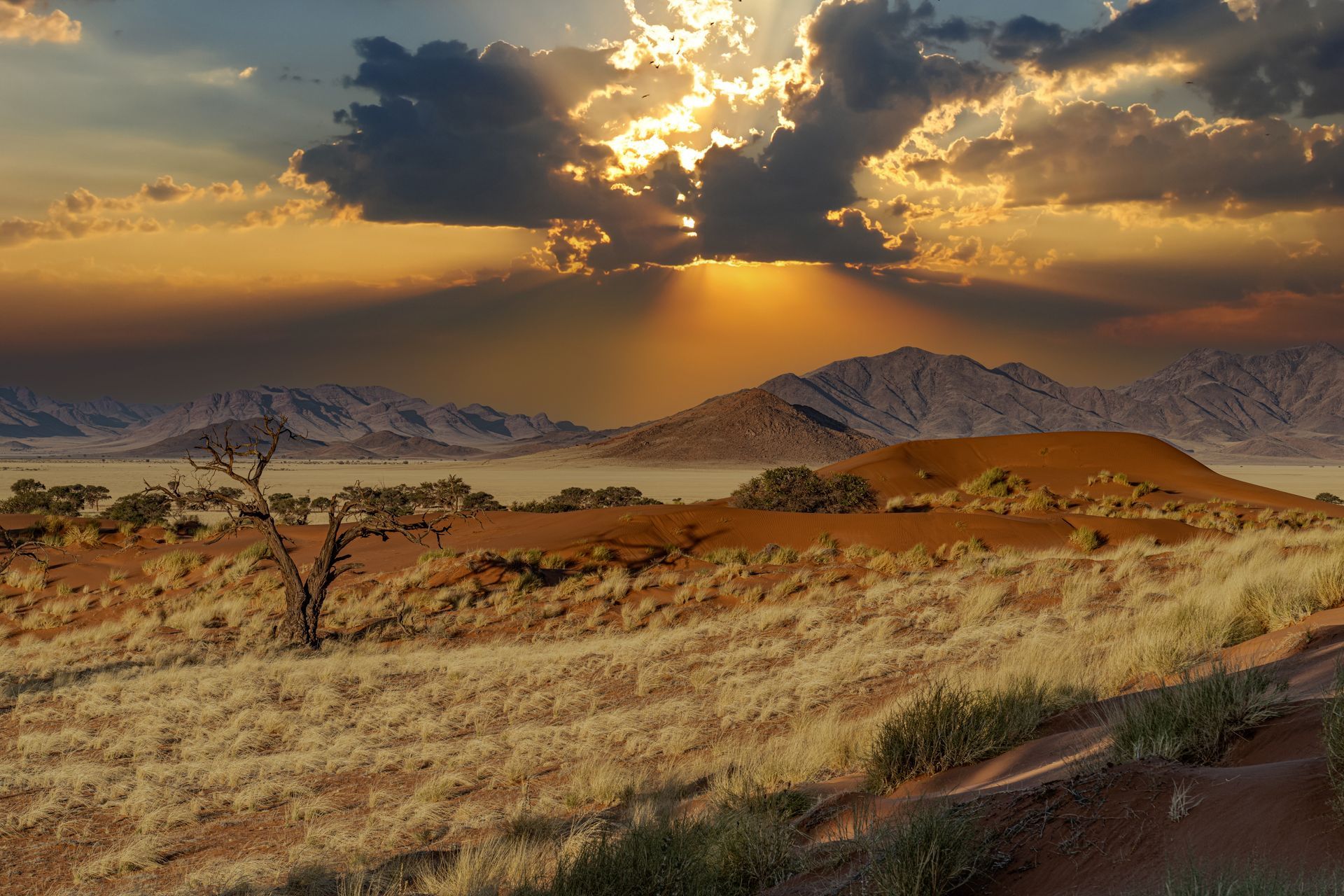
Slide title
Write your caption hereButton
DAMARALAND
A breathtakingly beautiful mountainous region of Namibia, Damaraland is notable for its dramatic landscapes, the towering peaks of the Brandberg - the country's highest mountain range - and ancient petroglyphs carved into the rocks of Twyfelfontein thousands of years ago.
A petrified forest that dates back millions of years to a time when dinosaurs roamed what was then a tropical paradise stands testament to the astounding history of this land.
Damaraland's rugged yet beautiful rocky landscape is characterised by valleys and dry riverbeds that carve their way through deep gorges and ancient geological features. This is home to Namibia's desert-adapted elephants with elongated limbs and broad soles that are able to withstand the extreme environment, rock and sand. They travel huge distances through the dry river beds in search of water.
You will also find the critically endangered desert lion in this region as well as various endemic desert plants such as the photogenic but poisonous Euphorbia virosa and the ancient Welwitschia mirabilis.
DAMARALAND
A breathtakingly beautiful mountainous region of Namibia, Damaraland is notable for its dramatic landscapes, the towering peaks of the Brandberg - the country's highest mountain range - and ancient petroglyphs carved into the rocks of Twyfelfontein thousands of years ago.
A petrified forest that dates back millions of years to a time when dinosaurs roamed what was then a tropical paradise stands testament to the astounding history of this land.
Damaraland's rugged yet beautiful rocky landscape is characterised by valleys and dry riverbeds that carve their way through deep gorges and ancient geological features. This is home to Namibia's desert-adapted elephants with elongated limbs and broad soles that are able to withstand the extreme environment, rock and sand. They travel huge distances through the dry river beds in search of water.
You will also find the critically endangered desert lion in this region as well as various endemic desert plants such as the photogenic but poisonous Euphorbia virosa and the ancient Welwitschia mirabilis.



ETOSHA NATIONAL PARK
Namibia’s premier savannah wilderness area, Etosha National Park is a vast 2,2-million hectares of woodland and grassy plains surrounding a massive white salt pan that's 120km long and up to 50km wide. The name Etosha means "great white area" in the local vernacular and life literally revolves around it and the waterholes spread across the park.
In the rainy season water gathers in the pan, creating fantastic mirage-like effects. But it's in the dry season that the waterholes become the focal point for game, with huge numbers of animals gathering together to drink. Ostrich, zebra, springbok, elephant, rhino, gemsbok and giraffe are found in numbers, mingling together around the water's edge. Predators set up ambushes at the waterholes so the action and anticipation is intense, making for a unique safari experience.
The amount of salt in the ground creates pale, powdery sand that's favoured by elephants for dust-bathing, coating them in a fine layer of white that makes them appear almost ghostly.

Slide title
Write your caption hereButton
Slide title
Write your caption hereButton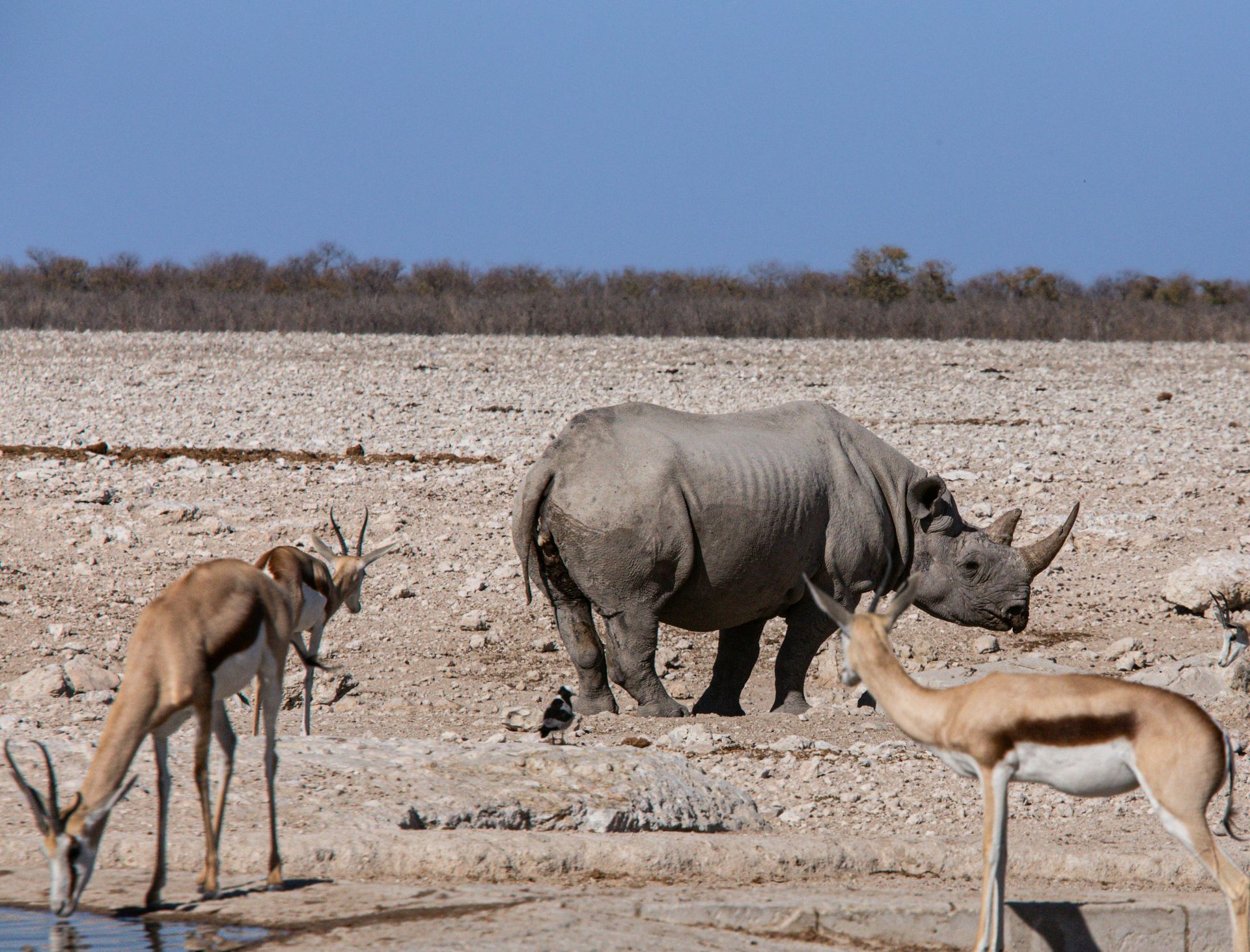
Slide title
Write your caption hereButton
ETOSHA NATIONAL PARK
Namibia’s premier savannah wilderness area, Etosha National Park is a vast 2,2-million hectares of woodland and grassy plains surrounding a massive white salt pan that's 120km long and up to 50km wide. The name Etosha means "great white area" in the local vernacular and life literally revolves around it and the waterholes spread across the park.
In the rainy season water gathers in the pan, creating fantastic mirage-like effects. But it's in the dry season that the waterholes become the focal point for game, with huge numbers of animals gathering together to drink. Ostrich, zebra, springbok, elephant, rhino, gemsbok and giraffe are found in numbers, mingling together around the water's edge. Predators set up ambushes at the waterholes so the action and anticipation is intense, making for a unique safari experience.
The amount of salt in the ground creates pale, powdery sand that's favoured by elephants for dust-bathing, coating them in a fine layer of white that makes them appear almost ghostly.
ETOSHA NATIONAL PARK
Namibia’s premier savannah wilderness area, Etosha National Park is a vast 2,2-million hectares of woodland and grassy plains surrounding a massive white salt pan that's 120km long and up to 50km wide. The name Etosha means "great white area" in the local vernacular and life literally revolves around it and the waterholes spread across the park.
In the rainy season water gathers in the pan, creating fantastic mirage-like effects. But it's in the dry season that the waterholes become the focal point for game, with huge numbers of animals gathering together to drink. Ostrich, zebra, springbok, elephant, rhino, gemsbok and giraffe are found in numbers, mingling together around the water's edge. Predators set up ambushes at the waterholes so the action and anticipation is intense, making for a unique safari experience.
The amount of salt in the ground creates pale, powdery sand that's favoured by elephants for dust-bathing, coating them in a fine layer of white that makes them appear almost ghostly.



SKELETON COAST & KAOKAVELD
Namibia's desolate northern coastline is a harsh land of sand, stone and rock and the final resting place of countless ships that have fallen foul of treacherous seas... Their rusting carcasses are strewn along endless beaches, but it's the bones of stranded whales that once littered the shoreline that most probably gave it its name. Indeed, the Himba people used to build their huts using whale bones.
Stretching from Swakopmund in the south to Kunene River and the border with Angola in the north, the Skeleton Coast borders one of the most remote and sparsely populated regions on earth - the Kaokoveld. The hostility of the environment is matched by its beguiling beauty and the amazing animals that call it home.
Game viewing nets a selection of rare birds, antelope, giraffe and even the odd desert-adapted elephant, and while desert lions are occasionally spotted it's the Skeleton Coast's Cape fur seal colonies that regularly attract the more unusual predators like jackal and brown hyena.
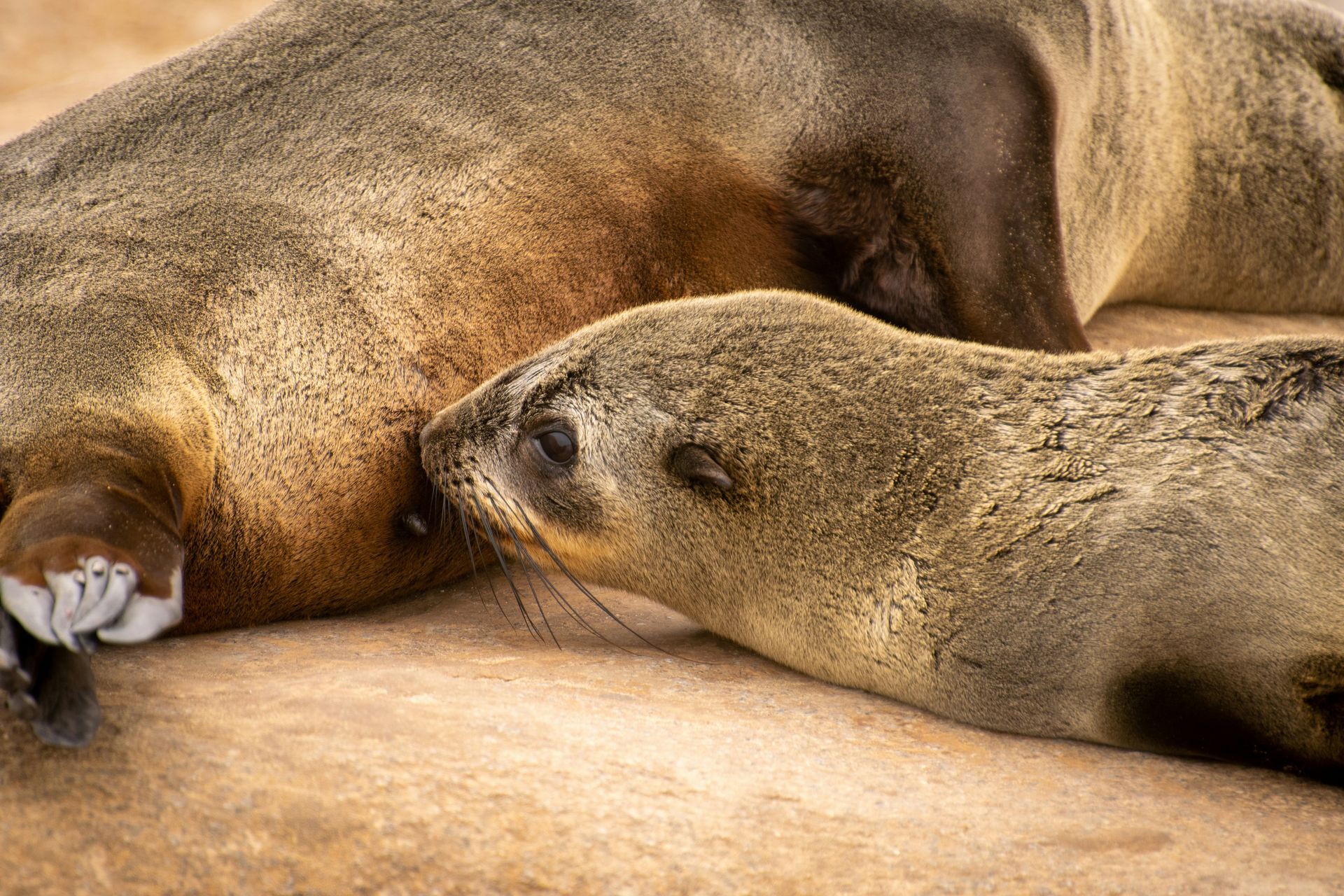
Slide title
Write your caption hereButton
Slide title
Write your caption hereButton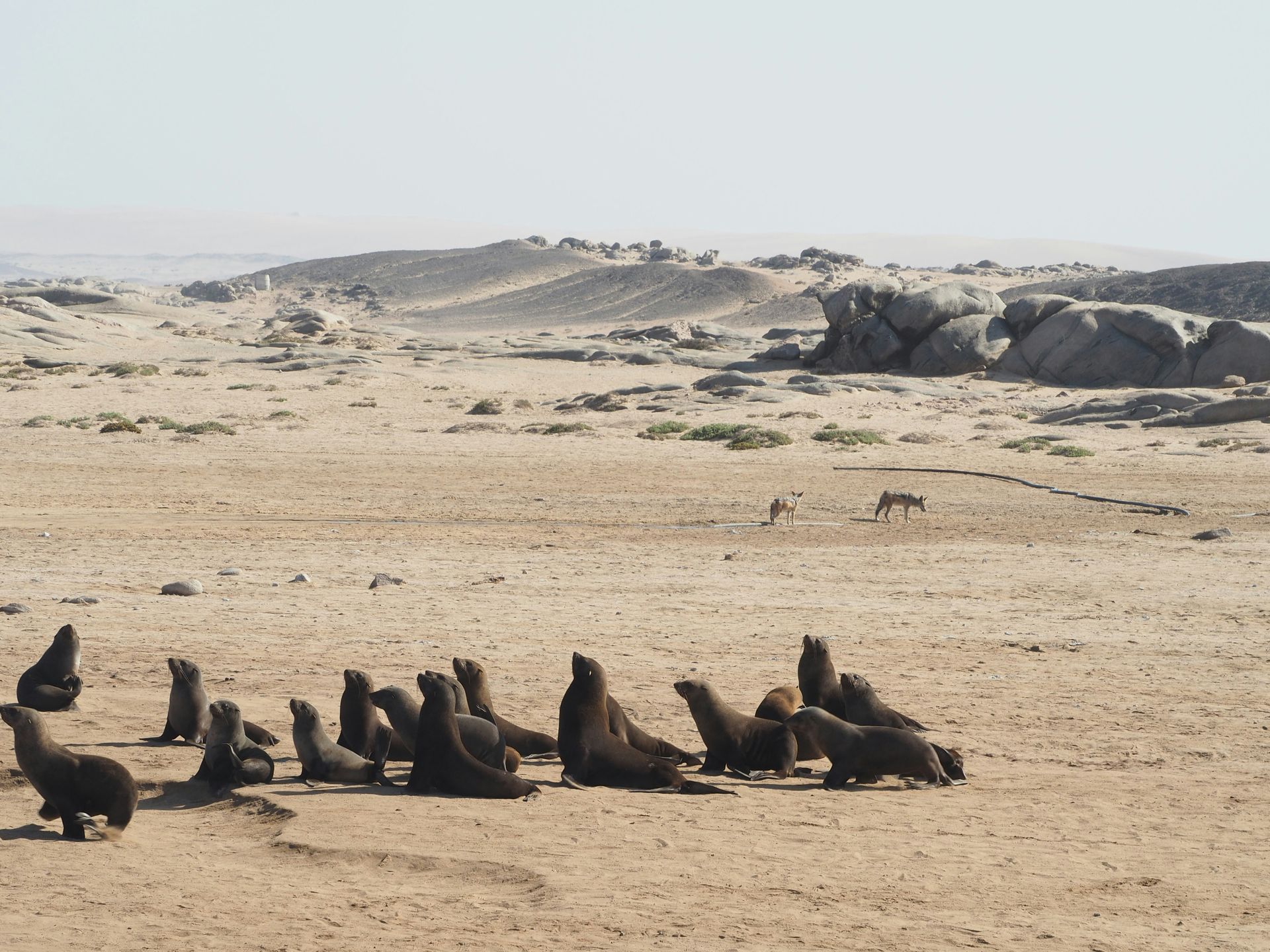
Slide title
Write your caption hereButton
SKELETON COAST & KAOKAVELD
Namibia's desolate northern coastline is a harsh land of sand, stone and rock and the final resting place of countless ships that have fallen foul of treacherous seas... Their rusting carcasses are strewn along endless beaches, but it's the bones of stranded whales that once littered the shoreline that most probably gave it its name. Indeed, the Himba people used to build their huts using whale bones.
Stretching from Swakopmund in the south to Kunene River and the border with Angola in the north, the Skeleton Coast borders one of the most remote and sparsely populated regions on earth - the Kaokoveld. The hostility of the environment is matched by its beguiling beauty and the amazing animals that call it home.
Game viewing nets a selection of rare birds, antelope, giraffe and even the odd desert-adapted elephant, and while desert lions are occasionally spotted it's the Skeleton Coast's Cape fur seal colonies that regularly attract the more unusual predators like jackal and brown hyena.
SKELETON COAST & KAOKAVELD
Namibia's desolate northern coastline is a harsh land of sand, stone and rock and the final resting place of countless ships that have fallen foul of treacherous seas... Their rusting carcasses are strewn along endless beaches, but it's the bones of stranded whales that once littered the shoreline that most probably gave it its name. Indeed, the Himba people used to build their huts using whale bones.
Stretching from Swakopmund in the south to Kunene River and the border with Angola in the north, the Skeleton Coast borders one of the most remote and sparsely populated regions on earth - the Kaokoveld. The hostility of the environment is matched by its beguiling beauty and the amazing animals that call it home.
Game viewing nets a selection of rare birds, antelope, giraffe and even the odd desert-adapted elephant, and while desert lions are occasionally spotted it's the Skeleton Coast's Cape fur seal colonies that regularly attract the more unusual predators like jackal and brown hyena.



SOSSUSVLEI
Famous for its iconic shimmering red sand dunes that tower as high as 400m and its parched, white pan and "vleis" littered with dead camelthorn trees, Sossusvlei has become one of the world's most sought after desert destinations.
Its name literally translates to "dead-end marsh" and Sossusvlei marks the spot where the dunes of the Namib Naukluft National Park come together and prevent the Tsauchab River from flowing to the Atlantic Ocean, some 60km to the west. The dry climate of the region seldom enables the river to flow as far as Sossusvlei which remains bone dry for years at a time. However, during an exceptional rainy season the river manages to reach Sossusvlei, filling the pan with water and turning it into a lake with a surface like polished glass that reflects everything around it. The water can take as long as a year to evaporate.
The dunes in this area are some of the highest in the world and offer energetic visitors the chance to climb them and take advantage of some of the most incredible views in Africa.
Despite the harsh desert conditions in the area, a wide variety of plants and animals that have adapted to survive call Sossusvlei home. You'll see ostrich, springbok and gemsbok among the dunes as well as bat-eared fox,
black-backed jackal and aardwolf.
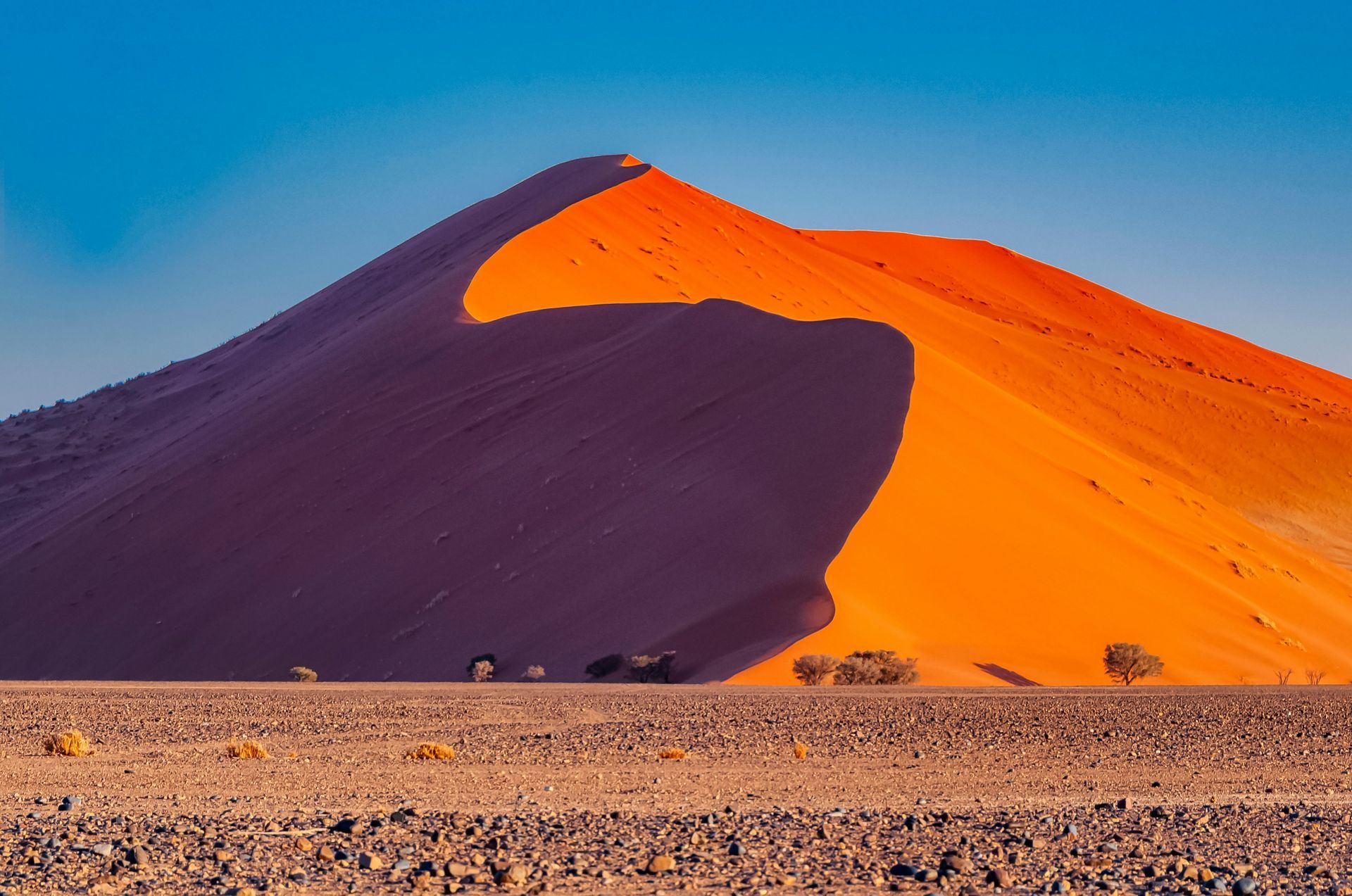
Slide title
Write your caption hereButton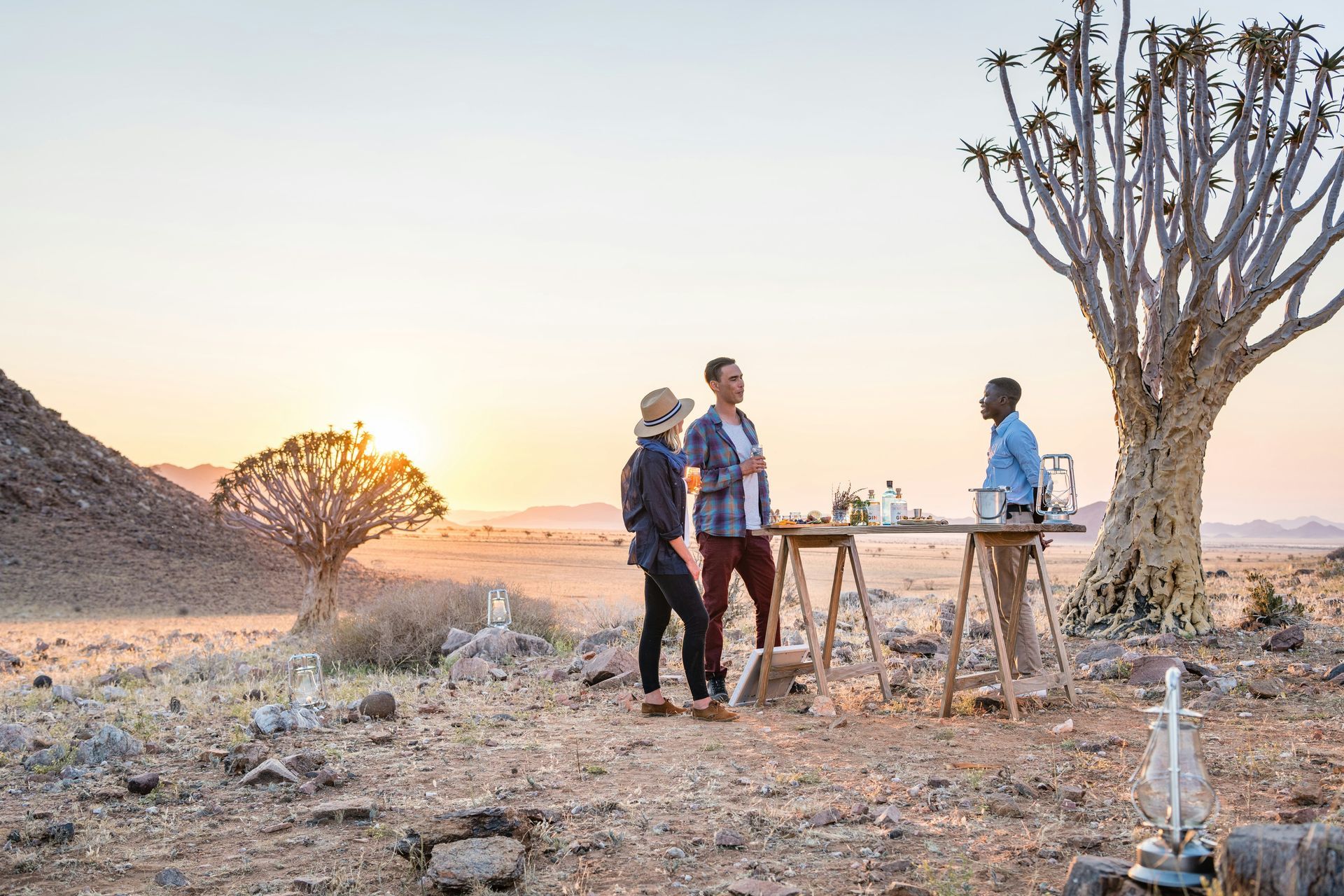
Slide title
Write your caption hereButton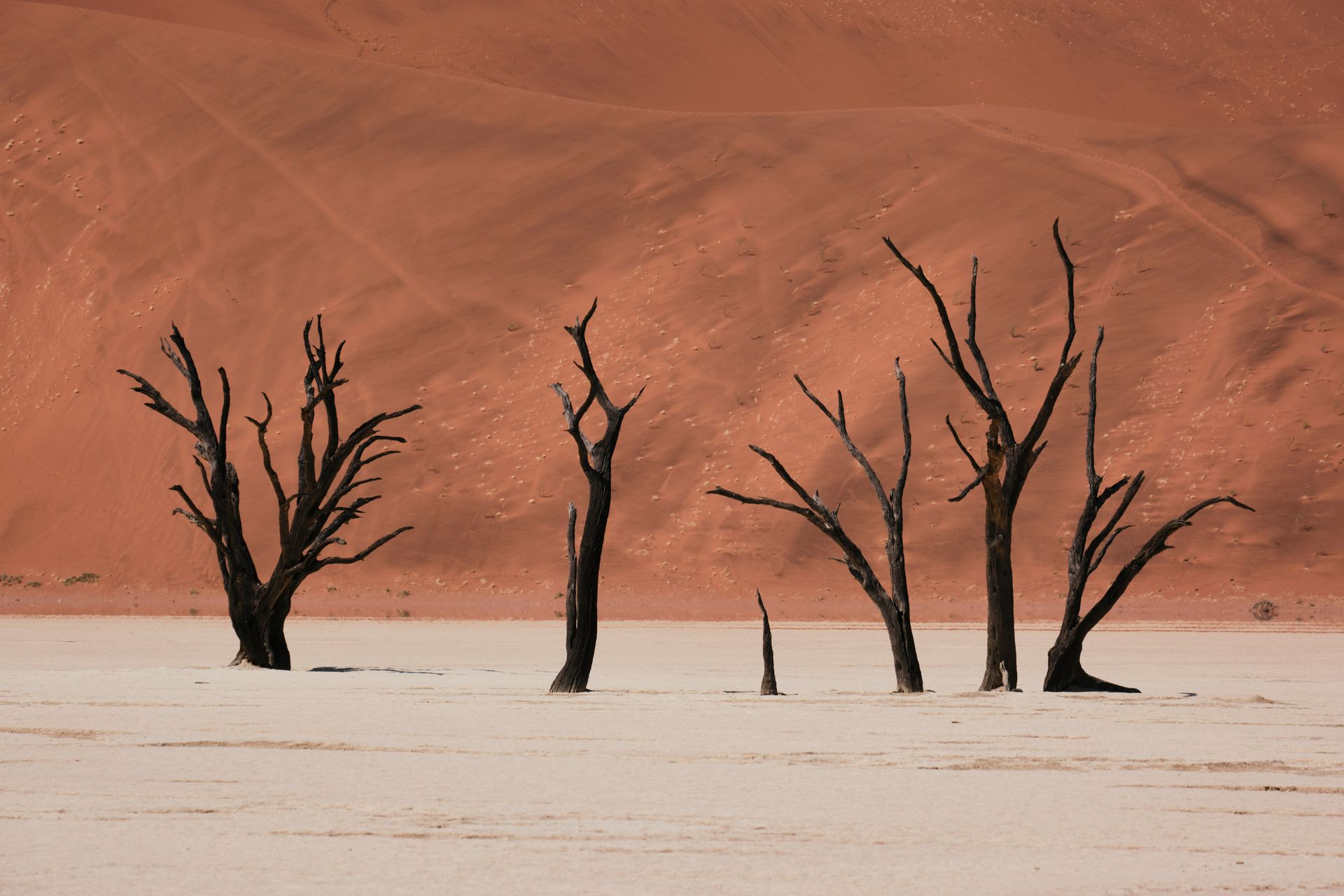
Slide title
Write your caption hereButton
SOSSUSVLEI
Famous for its iconic shimmering red sand dunes that tower as high as 400m and its parched, white pan and "vleis" littered with dead camelthorn trees, Sossusvlei has become one of the world's most sought after desert destinations.
Its name literally translates to "dead-end marsh" and Sossusvlei marks the spot where the dunes of the Namib Naukluft National Park come together and prevent the Tsauchab River from flowing to the Atlantic Ocean, some 60km to the west. The dry climate of the region seldom enables the river to flow as far as Sossusvlei which remains bone dry for years at a time. However, during an exceptional rainy season the river manages to reach Sossusvlei, filling the pan with water and turning it into a lake with a surface like polished glass that reflects everything around it. The water can take as long as a year to evaporate.
The dunes in this area are some of the highest in the world and offer energetic visitors the chance to climb them and take advantage of some of the most incredible views in Africa.
Despite the harsh desert conditions in the area, a wide variety of plants and animals that have adapted to survive call Sossusvlei home. You'll see ostrich, springbok and gemsbok among the dunes as well as bat-eared fox,
black-backed jackal and aardwolf.
SOSSUSVLEI
Famous for its iconic shimmering red sand dunes that tower as high as 400m and its parched, white pan and "vleis" littered with dead camelthorn trees, Sossusvlei has become one of the world's most sought after desert destinations.
Its name literally translates to "dead-end marsh" and Sossusvlei marks the spot where the dunes of the Namib Naukluft National Park come together and prevent the Tsauchab River from flowing to the Atlantic Ocean, some 60km to the west. The dry climate of the region seldom enables the river to flow as far as Sossusvlei which remains bone dry for years at a time. However, during an exceptional rainy season the river manages to reach Sossusvlei, filling the pan with water and turning it into a lake with a surface like polished glass that reflects everything around it. The water can take as long as a year to evaporate.
The dunes in this area are some of the highest in the world and offer energetic visitors the chance to climb them and take advantage of some of the most incredible views in Africa.
Despite the harsh desert conditions in the area, a wide variety of plants and animals that have adapted to survive call Sossusvlei home. You'll see ostrich, springbok and gemsbok among the dunes as well as bat-eared fox,
black-backed jackal and aardwolf.



FISH RIVER CANYON
The second largest canyon in Africa, the Fish River Canyon stretches for a colossal 160km, is up to 27km wide and reaches depths of 550m. Carved by the Fish River over millions of years, the canyon snakes through Namibia's southern reaches, showcasing a dramatic landscape of sculpted rock faces, colourful layers of sediment, and deep ravines.
The Fish River Canyon is a haven for adventure seekers. Hiking enthusiasts can embark on the multi-day Fish River Canyon Hiking Trail, a challenging yet rewarding experience that traverses the heart of the canyon. The trail offers breathtaking scenery and a chance to immerse oneself in the canyon's remote beauty.
For those who prefer a less strenuous experience, scenic viewpoints like Hobas Viewpoint and Canyon Lookout provide stunning panoramas of the canyon's vastness. Keep an eye out for the rare Hartmann's mountain zebra, springbok, and black eagles that call the canyon home.
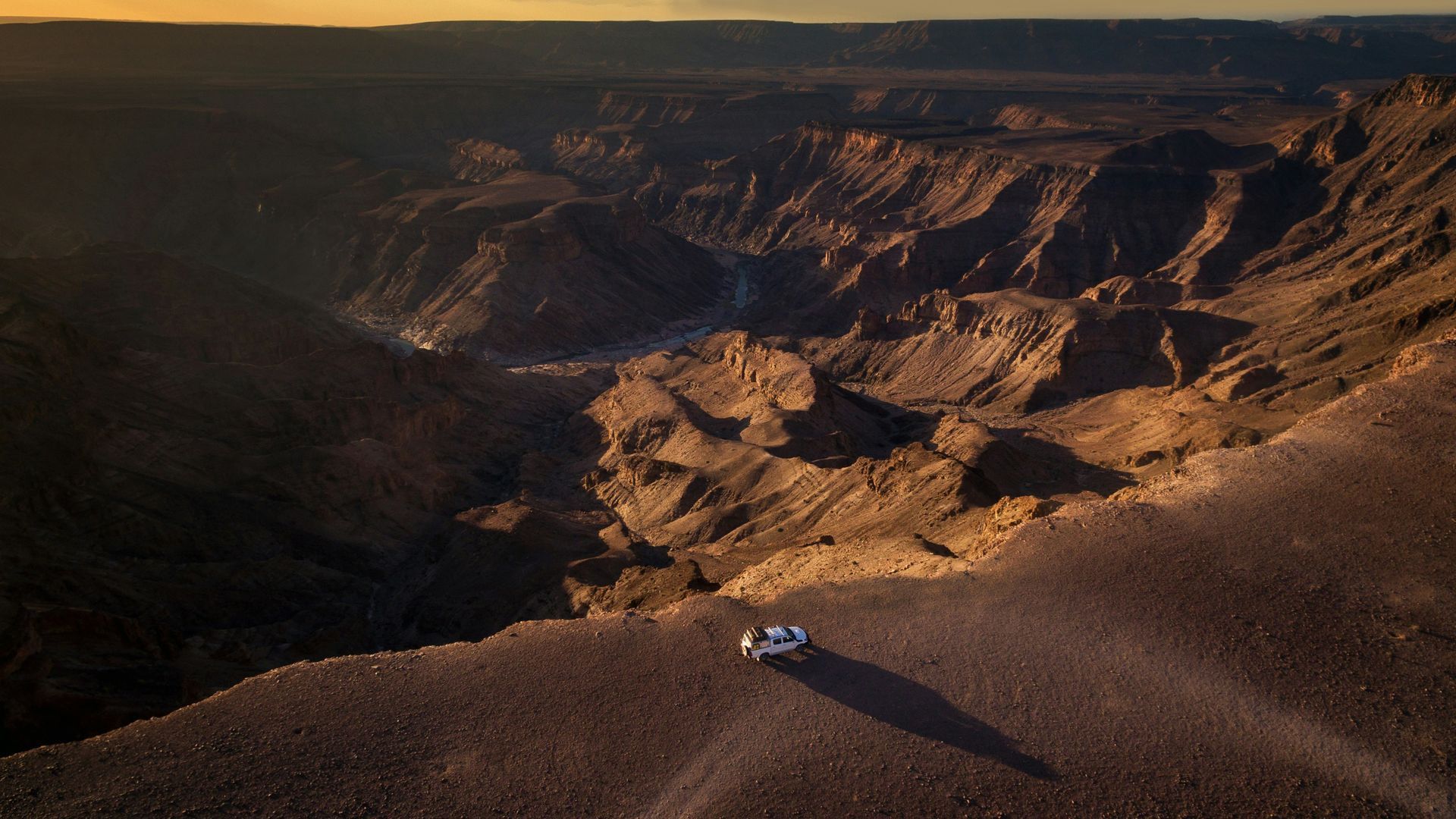
Slide title
Write your caption hereButton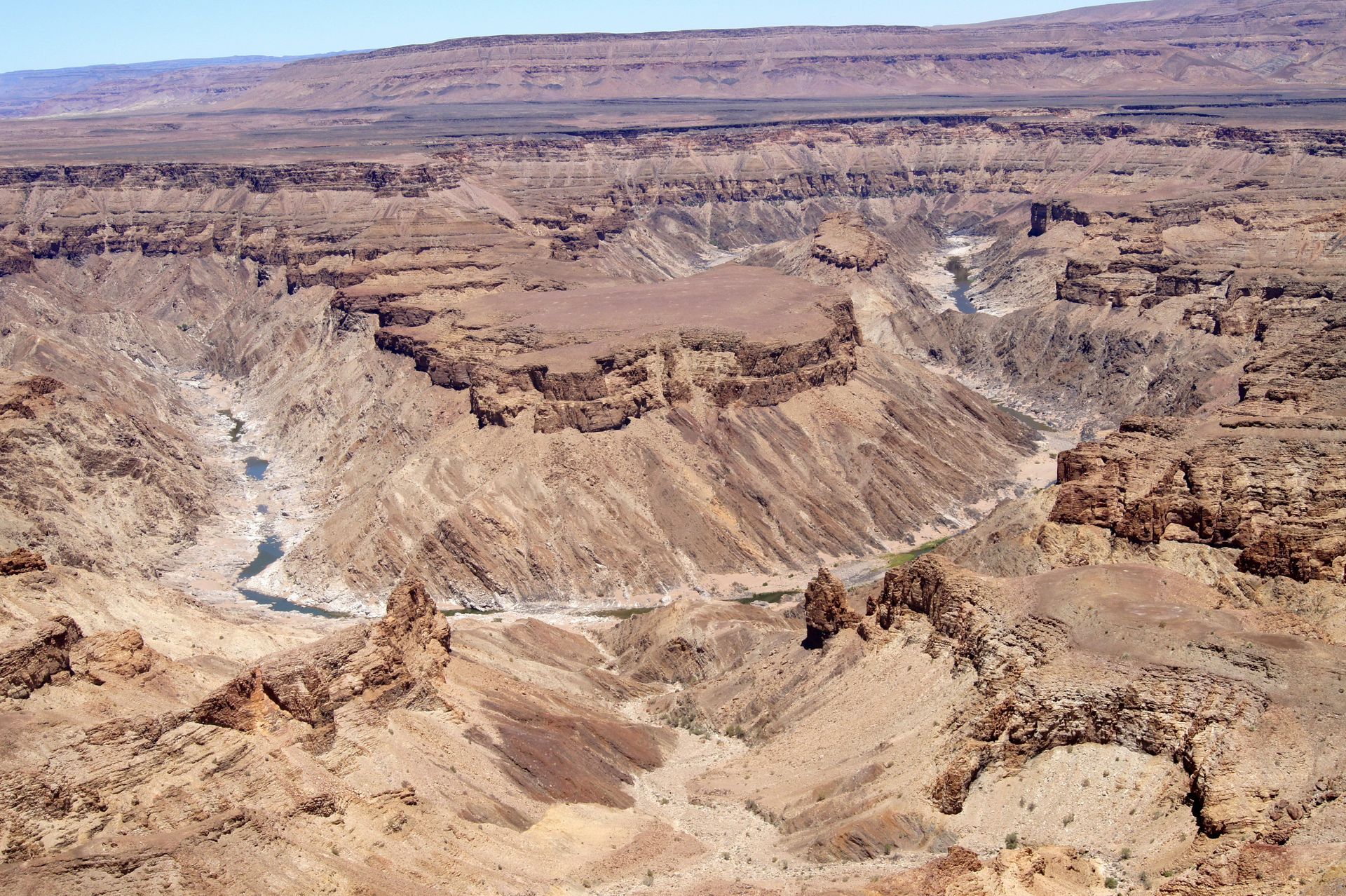
Slide title
Write your caption hereButton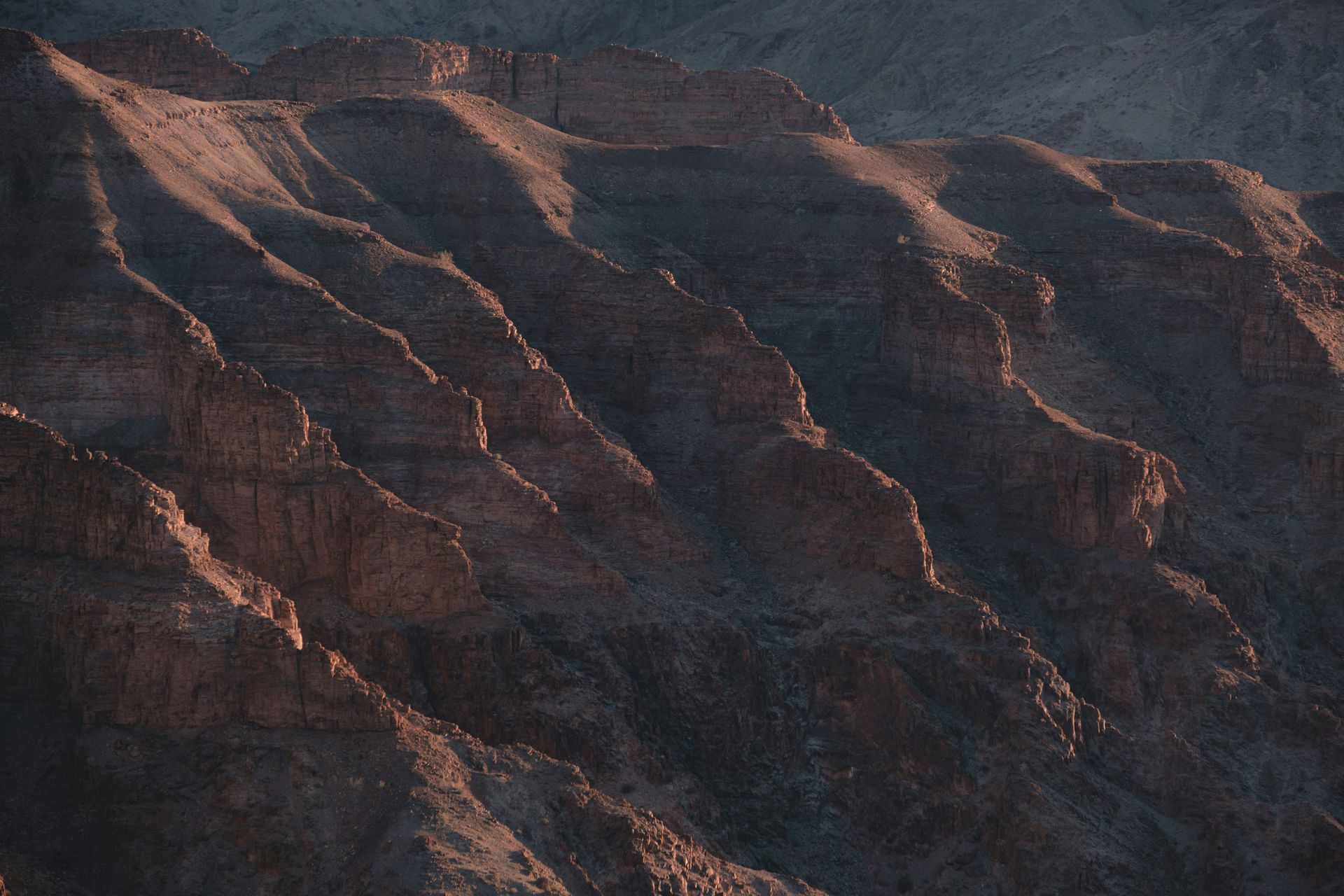
Slide title
Write your caption hereButton
FISH RIVER CANYON
The second largest canyon in Africa, the Fish River Canyon stretches for a colossal 160km, is up to 27km wide and reaches depths of 550m. Carved by the Fish River over millions of years, the canyon snakes through Namibia's southern reaches, showcasing a dramatic landscape of sculpted rock faces, colourful layers of sediment, and deep ravines.
The Fish River Canyon is a haven for adventure seekers. Hiking enthusiasts can embark on the multi-day Fish River Canyon Hiking Trail, a challenging yet rewarding experience that traverses the heart of the canyon. The trail offers breathtaking scenery and a chance to immerse oneself in the canyon's remote beauty.
For those who prefer a less strenuous experience, scenic viewpoints like Hobas Viewpoint and Canyon Lookout provide stunning panoramas of the canyon's vastness. Keep an eye out for the rare Hartmann's mountain zebra, springbok, and black eagles that call the canyon home.
FISH RIVER CANYON
The second largest canyon in Africa, the Fish River Canyon stretches for a colossal 160km, is up to 27km wide and reaches depths of 550m. Carved by the Fish River over millions of years, the canyon snakes through Namibia's southern reaches, showcasing a dramatic landscape of sculpted rock faces, colourful layers of sediment, and deep ravines.
The Fish River Canyon is a haven for adventure seekers. Hiking enthusiasts can embark on the multi-day Fish River Canyon Hiking Trail, a challenging yet rewarding experience that traverses the heart of the canyon. The trail offers breathtaking scenery and a chance to immerse oneself in the canyon's remote beauty.
For those who prefer a less strenuous experience, scenic viewpoints like Hobas Viewpoint and Canyon Lookout provide stunning panoramas of the canyon's vastness. Keep an eye out for the rare Hartmann's mountain zebra, springbok, and black eagles that call the canyon home.



Want to go to Namibia?
Explore with Claire's stories
Want to go to Namibia?
Explore with Claire's stories
Want to go to Namibia?
Explore with Claire's stories



Phone: +27 82 598 3168
Email: info@hasslefreeafrica.com
124 Gladiolus Ave
Brenton on Sea
Knysna
6571
Sunny South Africa's gorgeous Garden Route
Designed & powered by: The Safari Collective
All Rights Reserved | Hassle Free Africa
Designed & powered by: The Safari Collective
All Rights Reserved | Hassle Free Africa




